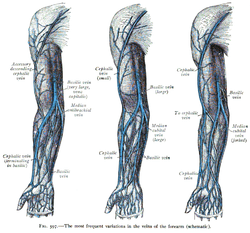Median cubital vein
| Median cubital vein | |
|---|---|
 Superficial veins of the upper limb. The median cubital vein is labelled (in latin) - Vena mediana cubiti. | |
| Details | |
Source | cephalic vein |
| Drains to | basilic vein |
| Identifiers | |
| Latin | vena mediana cubiti |
| TA | A12.3.08.019 |
| FMA | 22963 |
In human anatomy, the median cubital vein (or median basilic vein) is a superficial vein of the upper limb. It connects the basilic and cephalic vein and is often used for venipuncture (taking blood). It lies in the cubital fossa superficial to the bicipital aponeurosis.
There exists a fair amount of variation of the median cubital vein. More commonly the vein forms an H-pattern with the cephalic and basilic veins making up the sides. Other forms include an M-pattern, where the vein branches to the cephalic and basilic veins.
References
Additional Images
 The most frequent variations of the veins of the forearm (schematic).
The most frequent variations of the veins of the forearm (schematic).
| Dissection images |
|---|
|
See also
External links
- Anatomy photo:07:st-0703 at the SUNY Downstate Medical Center
- Radiology image: UpperLimb:18VenoFo from Radiology Atlas at SUNY Downstate Medical Center (need to enable Java)
This article is issued from Wikipedia - version of the 1/11/2015. The text is available under the Creative Commons Attribution/Share Alike but additional terms may apply for the media files.